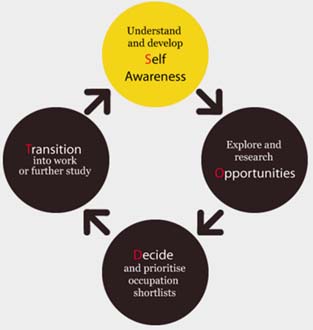Forging Luck-Ready Futures: The Synergy of Opportunity Awareness and Luck Readiness
20/11/2023
Trent Loader is an Assistant Director within the Careers and International Skills Division of the Department of Employment and Workplace Relations. He has recently submitted his Doctoral Thesis centred around the Chaos Theory of Careers focusing on the question, 'How do adolescents perceive change events in relation to opportunity awareness?'.

In the ever-evolving landscape of career development, the concepts of Opportunity Awareness and Luck Readiness stand out as guiding beacons. As career practitioners/advisors/teachers/counsellors, our role extends beyond simply preparing students and clients for job interviews; it encompasses sculpting individuals who are not just job seekers but architects of their own luck-ready futures.
Opportunity Awareness Unveiled:
Opportunity Awareness is the radar that tunes individuals into the frequency of potential opportunities in their surroundings. It's the cognitive process of understanding the professional landscape, recognising the needs and wants of the environment, and comprehending how one's skills can add value. Pitan (2023) succinctly captures it as "the ability of students to know about work opportunities and their requirements."
At its core, Opportunity Awareness is about providing support for students to gain exposure and understanding of the professional world awaiting them. It involves illuminating the various opportunities, understanding the demands different sectors might impose, and unravelling the rewards and satisfactions associated with diverse fields. It goes beyond the conventional focus on educational and occupational prospects, extending its scope to include leisure, community, and family opportunities (Law & Watts, 1977, 1996).

Hambly and Bomford (2018) add another layer to Opportunity Awareness: they see it not just as career coaching but as a strategic decision-making process. In the face of rapid changes in the job market, individuals must stay informed about labour market trends, job details, supply and demand, and future predictions. Career practitioners play a pivotal role in enhancing clients' information management skills, fostering curiosity, and making them adaptable to embrace new opportunities throughout their career journey.
The Entrepreneurial Lens on Opportunity:
Entrepreneurship studies have long emphasised the concept of opportunity, recognising its pivotal role in entrepreneurial endeavours (Hansen et al., 2011). While traditional career development research focused on an individual's relationship with an employing organisation, the modern world of work demands a broader perspective (Sardeshmukh & Smith-Nelson, 2011). The increasing casualisation of the workforce, diminished job security, and the emphasis on entrepreneurial opportunities have fuelled interest in careers that are boundaryless, protean, self-directed, and oriented towards seizing opportunities (Sullivan & Baruch, 2009).
Recognising opportunities requires a keen eye amidst shifting conditions. Baron (2006) notes that these opportunities stem from a complex interplay of evolving factors, including technological, economic, political, social, and demographic changes. In peripheral settings, opportunities often arise in response to fluctuations in information communication technology stability, market supply and demand, and alterations in government policy (Baron, 2006). Opportunity recognition involves two sub-phases: the phase when the opportunity exists, and an individual recognises it, and the phase when the opportunity is evaluated in relation to one's abilities and motivation to pursue it (Sardeshmukh & Smith-Nelson, 2011).
Human Capital and Cognitive Skills in Opportunity Recognition:
Research suggests that the ability to recognise opportunities is closely tied to an individual's human capital — their education, relevant prior knowledge, demographics, and experiences (Shane, 2000, 2003, 2008; Shane & Venkataraman, 2000). Not all aspects of human capital are equal; relevant experience often outweighs other factors (Chandler & Hanks, 1994; Sardeshmukh & Corbett, 2011).
Recent attention has shifted to cognitive skills and abilities influencing opportunity recognition (Mitchell et al., 2007). Entrepreneurial self-efficacy, pattern recognition, thinking using heuristics and shortcuts, intuition, structural alignment to prior knowledge, and creativity are identified as key factors (Sardeshmukh & Smith-Nelson, 2011). The interplay between cognitive abilities and the recognition of opportunities is well-acknowledged in the research literature (DeTienne & Chandler, 2004).
Pattern Recognition: The Key to Opportunity Awareness:
A vital concept in both Chaos Theory of Careers and Opportunity Awareness is pattern recognition. It involves perceiving complex and seemingly unrelated events as identifiable patterns (Matlin, 2002). Opportunities emerge from a complex pattern of changing conditions, and the recognition of opportunities depends on cognitive structures developed through previous life experiences (Baron, 2006).
The ability to identify connections between seemingly unrelated events is rooted in cognitive frameworks, enabling certain individuals to perceive patterns that others might overlook. Individuals lacking this cognitive ability or possessing less well-developed frameworks may struggle to recognise these patterns (Baron, 2006).
Luck Readiness: An Openness to Opportunity:
Luck is a phenomenon that spans various fields of study, from mathematics to psychology. It exerts a profound influence on our lives, turning the improbable into the possible (Wiseman, 2003). Luck readiness, as conceptualised by Nealt (2002), is about recognising, creating, utilising, and adapting to opportunities and outcomes occasioned by chance. It's being open to change and seizing the positive and negative potential outcomes of future events.
Pryor and Bright (2005) operationalised Luck Readiness into 8 measurable elements — Flexibility, Optimism, Risk, Curiosity, Persistence, Self-efficacy, Strategy, and Luckiness. These elements, considered the "21st-century skills in the field of career development," are essential for success in modern careers (Lengelle et al., 2015).
The Luck Readiness Index (LRI) can become a compass, guiding individuals toward a luck-ready future. It's not just about luck in the traditional sense but about cultivating a mindset and skill set that harnesses opportunities, no matter how they present themselves. As teachers and career practitioners we know that time with clients, be that one on one or in the classroom, is limited and precious. Experience has taught me that targeting that time by administering a pre-session/lesson test is always beneficial, not wasting time on what they already know. Administering the LRI initially, enables you to focus on that (or those particular) luck ready elements, where students may need a knowledge boost in order to optimise their luck readiness.
The Synergy of Opportunity Awareness and Luck Readiness:
In the realm of career development, Opportunity Awareness and Luck Readiness are not isolated concepts — they are interconnected threads weaving the fabric of a resilient and adaptable career journey. Opportunity Awareness provides the map, illuminating the diverse pathways in the professional landscape. Luck Readiness equips individuals with the tools and mindset to thrive on these paths.
As architects of luck-ready futures, our mission is clear — empower students and clients not just for their first job but for a lifetime of career success. Championing Opportunity Awareness and administering the Luck Readiness Index with purpose paves the way for individuals to navigate their careers with resilience, adaptability, and an unwavering readiness to seize opportunities.
In the synergy of Opportunity Awareness and Luck Readiness, we find the blueprint for crafting luck-ready futures. It's a call to action for career practitioners, teachers, and counsellors to not only impart knowledge but to instil a proactive mindset — one that not only recognises opportunities but is prepared to seize them.

Trent recently presented on this topic at the CDANZ International Conference 2023
References:
Baron, R. A. (2006). Opportunity recognition as pattern recognition: How entrepreneurs ‘connect the dots’ to identify new business opportunities. Academy of Management Perspectives, 20(1), 104–119.
Hambly, J. & Bomford, C. (2018), Opportunity awareness: Theory into practice, In Creative Career Coaching. Taylor & Francis Group.
Hansen, D.J., Shrader, R. & Monllor, J. (2011) Defragmenting definitions of entrepreneurial opportunity. Journal of Small Business Management, 49(12), 283-304.
Lengelle, R., Meijers, F., Poell, R., Geijsel, F. & Post, M. (2015). Career writing as a dialogue about work experience: A recipe for luck readiness? International Journal for Educational and Vocational Guidance, 16, 29-43.
Law, B.A., & Watts, A.G. (1977). Schools, careers and community. Church Information Office.
Pryor, R. G. L. & Bright, J. E. H. (2005). Luck readiness index manual. Sydney: Congruence/Bright and Associates.
Sardeshmukh, S. R & Smith-Nelson, R. M. (2011). Educating for an entrepreneurial career: Developing opportunity recognition ability. Australian Journal of Career Development, 20(3), 47-55.
Shane, S. (2000). Prior knowledge, and the discovery of entrepreneurial opportunities. Organisation Science, 11(4),448–469.
Shane, S. & Venkataraman, S. (2000). Entrepreneurship as a field of research. Academy of Management Review, 25, 217–226.
Sullivan, S.E. & Baruch, Y. (2009). Advances in career theory and research: A critical review and agenda for future exploration. Journal of Management, 35(6),1542.